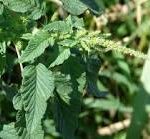Amaranthus spinosus
Uses
India. The plant is widely distributed but is found chiefly in Bengal and Malabar The leaves make a good pot-herb, though the sharp spines in their axils are troublesome to remove. It is a regular dietary item of the Bhils in Central India. The fruit [sic] and leaves are eaten in Alwar, Rajputana (Rajasthan); Bombay (Khandesh district, Bombay Presidency), and Balasore, in Bengal; (Madras Presidency): leaves eaten as greens. (Western Rajasthan): leaves eaten and tender stems eaten as greens. (Garhwal Himalayas): leaves boiled and eaten as vegetable. Malawi. Leaves used in making ndiwo, a relish.
Additional Information
- Name Authority:
- L.
- Vernaculars:
- Bengali: Kanta-nati, Kanta-nutia, Kanta-maris, Kuil rakha. Assam: Kanta-notiya, Kanta khudra. Santal: Janum-arak. Marathi: Kanti-mat. Bombay Presidency: Katla-matla. Guz: Kanta-nu-dant. Rajputana: Gojh, Cholai, Katarsa, Labrah. Rajasthan (western): Jangli cholai. Uttar Pradesh: Kanta-chulai, Katili-chouraie. Tamil: Mullu kirai. Telugu: Mulugoranta, Mundla-tota-kura, Mullu-thorta-kora, Nalla-doggali, Erra-mulu -goranta. Malabar: Mullan-chira. Kannada: Mullu-dantu, Mulhara-vesoppu. Sanskrit:Tenduliya. Burmese: Hinka-noe suba, Hinnoe-suba. English: Prickly Amaranth
- Misc:
- Chemical composition (after Hooper): Water = 52.10% (fresh). Fat = 2.21% (dry). Alblumenoids = 19.43% (dry). Carbohydrates = 38.35% (dry). Fibre = 19.82% (dry). Ash = 20.20% (dry). Nitrogen = 3.11% (dry). Phosphoric acid = 1.13% (dry). Silicates = 1.90% (dry)


